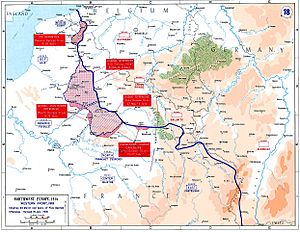Spring Offensive facts for kids
Quick facts for kids German Spring Offensive, 1918 |
|||||||
|---|---|---|---|---|---|---|---|
| Part of the Western Front of World War I | |||||||
 |
|||||||
|
|||||||
| Belligerents | |||||||
|
|
|||||||
| Commanders and leaders | |||||||
| Casualties and losses | |||||||
| 688,341 | 418,374 British 433,000 French Total: 851,374 |
||||||
The 1918 Spring Offensive was a series of big attacks by the German army during World War I. These attacks happened along the Western Front in France and Belgium. It was Germany's last major effort to win the war. The offensive lasted from March to July 1918.
Contents
What Was the Spring Offensive?
The Spring Offensive is also known as the Kaiserschlacht, which means "Kaiser's Battle." It was also called the Ludendorff Offensive, named after the German general Erich Ludendorff. These attacks were the deepest advances made by either side since the war began in 1914. Germany hoped to defeat the Allied forces before the United States could fully join the fight.
Why Did Germany Attack?
By 1918, World War I had been going on for several years. Both sides were tired, but Germany knew time was running out. The United States had recently joined the war. This meant many new soldiers and supplies would soon arrive to help the Allies.
Germany also had a new advantage. Russia had left the war after signing the Treaty of Brest-Litovsk. This freed up nearly 50 German army groups, called divisions. These divisions could now move from the Eastern Front to the Western Front. Germany saw this as their last chance to win.
The Plan: Operation Michael
The first and most important part of the Spring Offensive was called Operation Michael. The German army used new fighting methods. These were called "infiltration tactics." Instead of attacking everywhere at once, small groups of highly trained soldiers would sneak through weak points in the enemy lines. They would avoid strong points and attack from behind. This allowed them to move quickly and cause confusion.
The Battles Begin
The offensive began on March 21, 1918. German troops pushed forward with great speed. They surprised the Allied forces, especially the British. The Germans made significant gains, moving many miles into Allied territory. This was a tactical success, meaning they won battles on the ground.
However, the German army faced many problems. Their supply lines struggled to keep up with the fast advance. Soldiers became exhausted. They also captured areas that had been destroyed by years of fighting. These areas offered little food or shelter.
Why the Offensive Failed
Despite early successes, the Spring Offensive did not achieve Germany's main goal. They wanted to break the Allied lines completely and force them to surrender. But this did not happen. The Allied forces, led by generals like Ferdinand Foch and Douglas Haig, managed to hold their ground.
Germany lost a huge number of soldiers during the offensive. They had over 688,000 casualties. The Allies also suffered many losses, but they could replace their soldiers more easily. The arrival of fresh American troops also helped the Allies. Germany simply ran out of soldiers and supplies to continue their attacks. The offensive ended in July 1918.
What Happened Next?
The failure of the Spring Offensive was a turning point in World War I. Germany had used up its last reserves of strength. After this, the Allies launched their own counter-attacks. These attacks pushed the Germans back. The war ended just a few months later, in November 1918.
Images for kids
-
British Lewis gun team on the bank of the Lys canal during Battle of Hazebrouck, 15 April 1918







